
Extending from folklore, to literature, to cinema, there are many iconic monsters that make up the menagerie of Halloween time. And while some of the icons of Halloween come from very distinctive literary origins like Dracula and Frankenstein’s monster, there are others whose presence in the culture extend much further back and have no real true origin. Witches and zombies for example have haunted the imagination of generations through folklore, with many different cultures having their own unique take. And one particular creature that especially carries a long history with it is the werewolf. With a particularly strong folkloric history in Western Europe, tales of werewolves have been present for over the last millennia. There is something particularly captivating about the idea of transforming between species to go from man to beast. It’s not always a story about malevolence and savagery. Celtic folklore talks about spirits that inhabit the both the bodies of men and wolves and are protectors of nature. The tale of Beauty and the Beast likewise draws inspiration from old Gaelic folk tales. But when the rise of Gothic horror became popularized in the 18th and 19th centuries, the tales of werewolves went through their own transformation into something more foreboding and scary. Over time, canonical things began to be associated with werewolf beings, such as the transmissible nature of it’s curse through the act of attacking and infecting, as well as having a silver bullet being the one thing to end it’s life. Over time, the werewolf became an amalgamation of many different creature legends from across Europe and eventually turned into the being that we know today. Naturally, because of it’s popularity in pulp horror literature, the creature would make it’s way to the silver screen as well. Dating back to the early days of cinema, the Werewolf of Wolf Man would often be depicted through a quick dissolve between a human being and a live wolf, due to the limitations of the medium at that time. It wasn’t until cinema had developed more advanced visual effects during it’s Golden Age that we finally began to see the character fully realized on screen. What follows are some of the more noteworthy examples in cinematic history, all stemming from the basic canonical interpretation of the Western European concept of the Wolf Man creature.
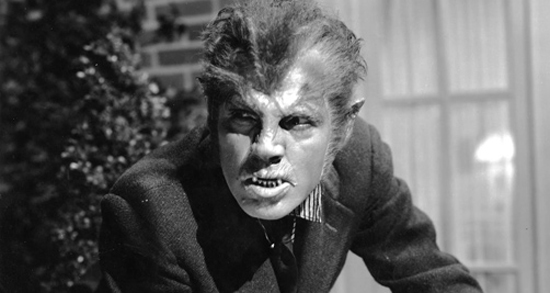
HENRY HULL in WEREWOLF OF LONDON (1935)
Here in this early British horror film do we find the first big cinematic representation of the werewolf legend. In particular, it’s the movie that establishes the character within a late Victorian pastiche, which has helped to link it with other Victorian era monsters like Dracula, the Invisible Man, and so on. One thing that helps to reinforce that era defining element in the character is that his origins here come from another literary inspiration, that of Robert Louis Stevenson’s Dr. Jekyll and Mr. Hyde. The titular Werewolf is a London based doctor named Wilfred Glendon (Henry Hull) and he finds London haunted by an unexplained creature that turns out to be him after he transforms into the creature at night. Like Jekyll and Hyde, Dr. Glendon has no memory of his altered self, but slowly the clues lead back to him, and he has to find a way to remove this curse before he ends up killing the things he loves. For an early talky horror film, the movie does alright in conveying the atmosphere of a gloomy old London where creature stalk the shadows at night. And for it’s time, the make-up effects on actor Henry Hull look pretty good; subtle, but still appropriately grotesque. The unfortunate thing that plagues the movie though is presence of Charlie Chan actor Warner Oland once again playing another character in yellow face; an unfortunate practice that was sadly all too common in that time. Here, he is werewolf hunter named Dr. Yogami, and Henry Hull ultimately makes a more convincing Wolf Man than Oland does an Asian. Otherwise, the movie does a fair enough job in bringing the image of a half man/half wolf to the big screen in a mostly terrifying way. That in the end ultimately helped to establish the standard on which most future interpretations would follow.

LON CHENEY JR. in THE WOLF MAN (1941)
Picking up the legacy that his father left behind, Lon Cheney Jr. would make a career that likewise left him recognized as a man with a thousand faces. Cheney Jr., like his father, did much of the make-up work himself for the many roles he took over the years, including some noteworthy appearances as monsters within the iconic Universal Pictures stable. Of all the characters he played, however, none were as more intricately tied to Lon Cheney Jr.’s legacy than the Wolf Man. And that distinction is well earned. Cheney’s Wolf Man is undeniably the gold standard of the character, and it’s in large part due not just to the incredible make-up work that he did to himself for the film, but also the physicality that he brought to it as well. In the movie, you can see subtle ways that Cheney tried to mimic the characteristics of a wolf into his performance, including the hunching of his back as well as walking around on the balls of his feet rather than the heel, which gives him a hind-leg look. The make-up is also pretty incredible as well, with Cheney just outright disappearing underneath it all. Though he still looks more man than beast, you can still see the effort Cheney put into creating a terrifying look for the character. His film also did a few noteworthy things that changed the character’s overall story. For one, it contemporized the tale, bringing it out of Victorian times and into the present day. It also made the Wolf Man American, though the setting is still English bound, with the unfortunate traveler succumbing to the curse while on his trip to inherit an estate. Cheney Jr. would go on to star in many future sequels to this popular original, and he even played the role again in some Abbot and Costello comedies alongside some other iconic monsters. Even though make-up effects and computer animation have advanced to a point where werewolves can look even more monstrous today, the original image that Lon Cheney Jr. presented here is still the one that defines the prototypical Hollywood werewolf.
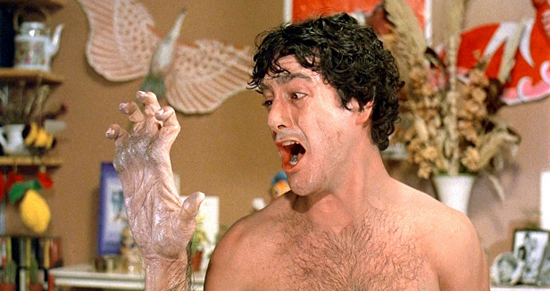
DAVID NAUGHTON in AN AMERICAN WEREWOLF IN LONDON (1981)
Nearly 40 years would pass before we would get another Hollywood werewolf that stood up to Lon Cheney Jr.’s classic. In between were a lot of low rent attempts at creating a captivating wolf man creature, often with unconvincing make-up and visual effects. Then came along a make-up virtuoso that would revolutionize the artform on film. His name is Rick Baker, and he would become one of the most prolific and groundbreaking effects artists of his generation. In an over 50 year career, Baker has won 7 Academy Awards for his work in Make-up effects, and naturally, his first win came for creating one of the most incredible cinematic werewolves in movie history. In John Landis’ horror/comedy, we find actors David Naughton and Griffin Dunne playing a pair of American tourist on a walking tour of England. Of course, things go awry when they are both attacked by a ravenous wolf. Dunne’s Jack is savagely killed, but Naughton’s David survives and ends up succumbing to the after effects of the attack. It what has to be one of the most iconic horror moments ever captured on screen, we see the full breadth of a werewolf transformation as David witnesses all of parts of his body warp and stretch into wolf form. With some amazing prosthetic and animatronic work, the full transformation is shockingly lifelike, and to this day remains a benchmark in practical visual effects. Even after the transformation, the Rick Baker make-up and mechanically enhanced final werewolf is still pretty impressive. But it’s that unforgettable transformation scene that really set this movie apart at the time, and made it into a classic. I think that it’s the fact that we are finally seeing the full breadth of a transformation between man and beast shown on screen that really captured the attention of the audience. No more using dissolves or other editing tricks. Here we see the whole grotesque procedure, which the looser Hollywood standards would finally allow after so many years. For Rick Baker, it would launch him into a legendary career afterwards, and as we would see, it wouldn’t be the last time he would play around in the realm of werewolves either.
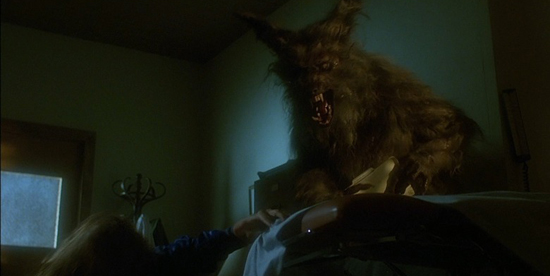
THE COLONY in THE HOWLING (1981)
Released in the same year as An American Werewolf in London, The Howling again uses make-up and effects by Rick Baker, who had quite the year. Though not as iconic as the Oscar-winning effects in the other film, The Howling’s own visual effects to bring it’s werewolves to life are still pretty impressive. One of the things that makes these werewolves stand out is how the look much less like real wolves and more like the creations of nightmares. With exaggerated, fang-filled jaws, extremely large pointy ears, and razor claw hands, these are monsters of a very different kind than what we’ve seen before with regards to werewolves. Made by director Joe Dante from a John Sayles screenplay, the movie ups the ante from other Werewolf movies by establishing not one Werewolf within it’s story, but a whole community of them. In the film, Dee Wallace plays an investigative reporter who finds herself in a secluded mountain resort after escaping a near death experience with a serial killer. Unfortunately, she soon learns that the simple town is not what it seems to be, and the quiet residents within it are in fact werewolves. The Colony, as they become known, defy many traits associated with the Werewolf myth, including being able to transform without the aid of a full moon. And in the movie, we also get our first cinematic example of Wolf Women on the big screen, including Dee Wallace’s character as she falls victim to the curse, even after escaping the colony. Considering the amount of work that it took to not just create a single werewolf for the movie but a whole town of them helps to make this an equally impressive feat for Rick Baker in addition to his work on London. But, as we would see again, Mr. Baker was not done yet with Werewolves in his prolific career.
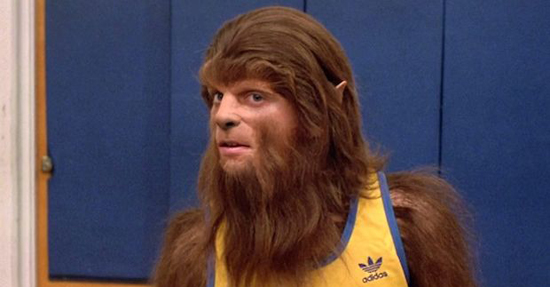
MICHAEL J. FOX in TEEN WOLF (1985)
Taking the iconography of werewolves in a decidedly different direction than we’ve seen, we have this film which puts the wolf man curse into a 1980’s teen comedy. What is interesting about this version of the werewolf story is that our main protagonist doesn’t gain his wolf form through the passing on of a curse through a wolf bite, but rather through genetics. Michael J. Fox’s Scott begins to suddenly transform one day while at school, which leads to some awkward situations, and later finds out from his father that he inherited the curse from him, as they descend from a long line of werewolves. Basically, the werewolf curse is equivalent to diabetes or other generationally inherited disease, and in some ways is shown here to be a metaphor for puberty, as Scott is growing up into his true adult form. It’s a movie that more or less sticks with it’s 80’s teen comedy clichés and only stands out because of this gimmick. The look of Michael J. Fox as a werewolf unfortunately is a far cry from the more transformational work done by Rick Baker in the previously mentioned movies, and looks more Sasquatch than Wolf Man as a result. At the same time, this isn’t trying to be a scary version of a Wolf Man, and instead it’s trying to fit within the confines of a silly comedy. Michael J. Fox’s natural charisma still shines through in the role, even when he looks ridiculous under all that hair. What is interesting is that this silly comedy would inspire a darker reimagining many years later for television with the CW series of the same name. That show followed the more idealized version of what a werewolf should look and act like, so in a way, this movie did eventually contribute to the continued legacy of Werewolves as a horror icon. It’s far from what you’d expect for a cinematic werewolf movie, but it’s uniqueness within the genre and popularity has helped to keep the Wolf Man a relevant character within cinema as a whole.
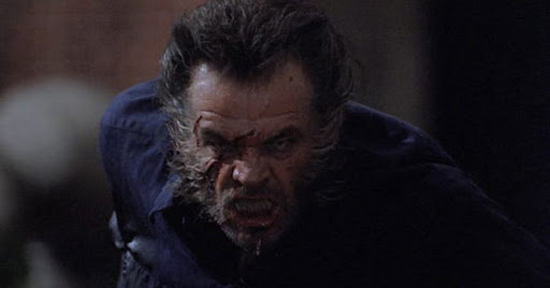
JACK NICHOLSON in WOLF (1994)
Rick Baker strikes once again, but here we find him accomplishing something a little more subtle. In this movie, the transformation never goes full wolf, and instead we see the actors more or less remain visible even after transitioning into their altered form. Rick Baker accomplishes the look by focusing on the actor’s eyes, hair, and teeth to convey the transformation, rather than relying on complex prosthetics and animatronics like he utilized for An American Werewolf in London. This was probably due to director Mike Nichols’ insistence on keeping things simple so that the actors performances could convey the transformation a lot more. Now, of all the actors called upon to portray a man turning into a werewolf, it’s just natural that the job would fall on Jack Nicholson, who’s already wolf-like to begin with. The movie is also a quite different re-telling of the classic story, putting the setting in modern day New England high society. Despite that, it otherwise sticks pretty close to classic werewolf movies we’ve seen before; especially the Lon Cheney version. Unfortunately, and maybe due to the lack of experience within the horror genre of all involved, the movie is a bit on the boring side. It’s hard to believe that a Mike Nichols movie starring Jack Nicholson, Michelle Pfeiffer, Christopher Plummer, and James Spader along with music by Ennio Morricone and make-up by the previously mentioned Baker would turn into something so dull. Where the problem lies is that, despite the best efforts of the actors, you never fully buy them as werewolves because of the lack of the lack of heavy-duty make-up work that we’re accustomed to. You bring in Rick Baker and just end up wasting his talent here. The only entertainment value comes from how over the top Jack Nicholson goes with his performance at times, as well as with how poorly executed the visual effects can be. Otherwise as Werewolf movies go, it falls flat. What it shouldn’t have done was try to bring prestige into a genre that was designed for pulp.
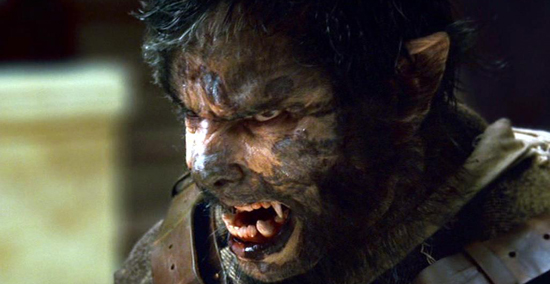
BENICIO DEL TORO in THE WOLFMAN (2010)
Riding that fine line between prestige and pulp better than Wolf did, this Joe Johnston directed film makes a valiant attempt to bring the werewolf back it’s Victorian set origins, and do so with all the advances in visual effects that are at our disposal now. Naturally, Rick Baker was called upon once again to bring this creature to imaginative life, and this time he was given much more reign to work his magic. It helps that he has an actor of intensity like Benicio Del Toro to work with as a canvas. Del Toro’s already rugged looks work well with what he ultimately will turn into. Director Joe Johnston, who had to step in last minute after original director Mark Romanek left the project, expertly uses his experience with visual effects to make the transformations between Benicio’s human and wolf forms look believable on screen. CGI is used effectively here, making the transitions far smoother than in years past, but once the transformation is complete, it’s all Rick Baker’s incredible prosthetic work and Del Toro’s ferocious performance from there. Though the movie is perhaps too bombastic at times, it nevertheless showcases incredible visual effects work that once again reinvents the way werewolves are presented on the big screen. The transformation moments in particular really reach for the grotesque in this film, with the character’s limbs and feature’s twisting and contorting in disturbing ways. Bringing the story back to it’s period setting also really helps to give the character more of a classical identity, which helps to solidify it’s place in the pantheon of great cinematic monsters. The one downside of the movie is that it never gets as scary as it seems to strive to be. It probably has to do with the fact that the movie is trying to hit a more general audience, and therefore the movie pulls a few punches. Del Toro still is intense enough to make for a good werewolf, but the movie around his performance feels more conventional than it needs to be. Despite that, it does give us some R-Rated gore, and it helps that Rick Baker’s effects work do not disappoint. It’s a fair example of an ideal werewolf in a not so ideal werewolf movie.
There have honestly been more werewolves in movies and television than any other classic movie monster. Even more than vampires, since through some convenient cinematic cross-pollination, Werewolves and Vampires have canonically become mortal enemies of one another. It’s probably because of it’s long legacy in folklore that the concept of werewolves has endured for as long as it has. The connection between man and nature is a compelling one in storytelling, and the idea of a transformation between species like we see with werewolves is one that still grabs at the imagination. Werewolves still are present in many forms of media today, including playing a big part in non horror franchises like Harry Potter and Twilight. Even media directed at younger audiences feature werewolves prominently in them, like the animated Hotel Transylvania franchise. For the most stand-out cinematic versions that I spotlighted here in this article, what they’ve often represented are benchmark achievements in movie visual effects. It takes a lot of work to make a believable transformation between man and wolf come to life on the silver screen, and thanks to two wizards in particular named Lon Cheney Jr. and Rick Baker, we’ve had some amazing cinematic werewolves in our history. You can still see the imprint of Lon Cheney’s Wolf Man in most modern day versions of werewolves, particularly in the body language that today’s actors try to incorporate into their performance. And Rick Baker’s other-worldly prosthetics really help to make the actors disappear while at the same time giving them the ability to still perform underneath all those layers of make-up. Even with all the advances made in digital effects, there’s still something satisfying in seeing a genuine effort to create a realistic cinematic werewolf with simple old make-up effects. That ultimately has helped the Wolf Man and other werewolves of cinema stand out so well over time. It’s a true expression of performance and effects working together that helps to bring this iconic creature to full life, making it a true cinematic original.